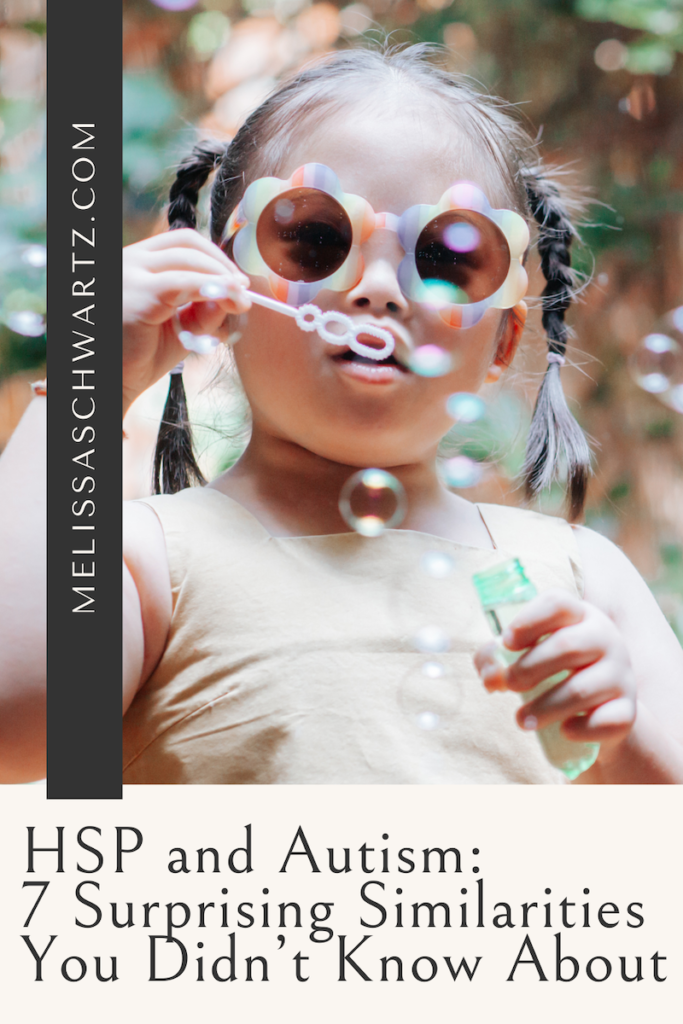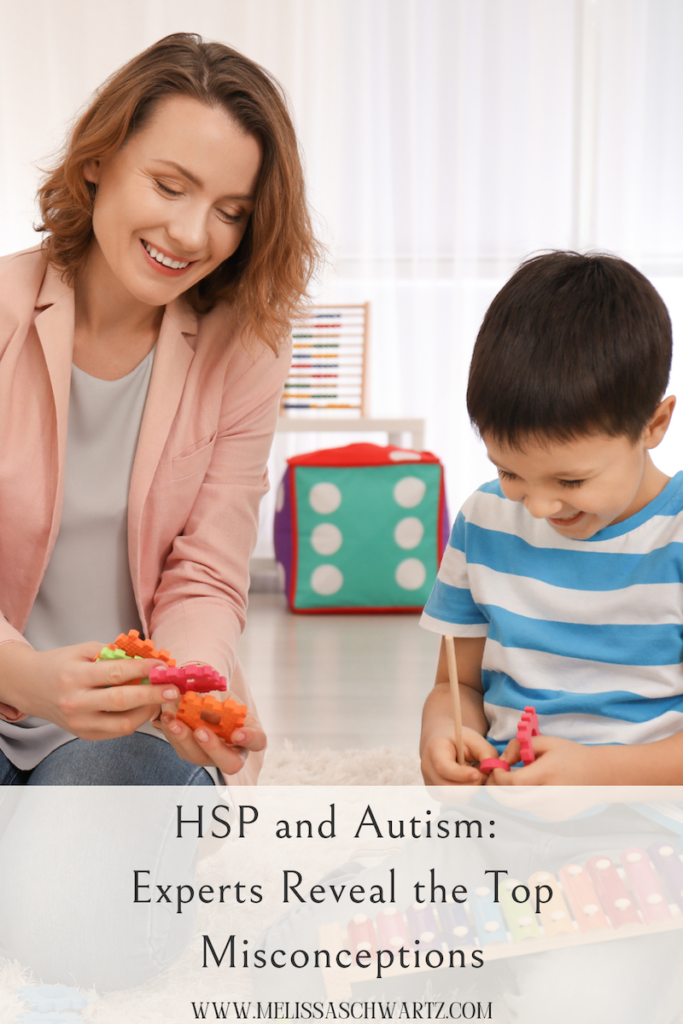Disclaimer: This blog post about HSP and Autism is for informational purposes only and does not constitute medical advice.
If you or someone you love identifies as a Highly Sensitive Person (HSP), or has recently been exploring the autism spectrum, you may have found yourself asking: What’s the difference between an HSP and someone with Autism Spectrum Disorder (ASD)? Or even more confusing: Can you be both? Let’s dive in.
Hi, my name is Melissa Schwartz, expert in the field of Highly Sensitive Children and co-founder of Leading Edge Parenting, and I have helped highly sensitive families and adults around the globe navigate questions just like this. Whether you’re a parent, a clinician, or someone trying to understand your own experience, this post will help clarify some of the confusion around high sensitivity, sensory processing sensitivity (SPS), and autism spectrum disorder.

1. What Is a Highly Sensitive Person (HSP)?
A Highly Sensitive Person (HSP) has a biological trait known as sensory processing sensitivity (SPS), a concept pioneered by Dr. Elaine Aron. This trait affects about 15-20% of the population and leads to a heightened awareness of subtleties in the environment. Highly sensitive people (HSPs) tend to notice details others miss, have strong emotional reactions, and are more easily affected by sensory input, such as loud noises or strong smells.
Many HSPs feel overwhelmed by sensory stimuli, especially in chaotic or overstimulating environments. While this high sensitivity is not a disorder, it can impact a person’s mental health if they don’t understand or honor their needs.
2. What Is Autism Spectrum Disorder (ASD)?
Autism Spectrum Disorder (ASD) is a neurodevelopmental condition that affects communication, behavior, and how individuals relate to the world around them. Autistic individuals often exhibit repetitive behaviors, may struggle with eye contact or social situations, and can have heightened sensitivity to environmental stimuli like textures, lighting, or sound.
While the spectrum is broad and unique to each individual, key features often include difficulty interpreting social cues, preference for routines, and differences in how sensory input is processed. Some people with ASD feel anxious in unfamiliar settings, especially when faced with unpredictable sensory stimuli.
3. The Overlap: Sensory Sensitivities
This is where things get tricky. Both HSPs and people with autism can experience heightened sensitivity to their environments. Loud noises, bright lights, and strong smells can trigger discomfort or distress in both groups.
But the why is different. HSPs process sensory information more deeply due to SPS, often leading to rich emotional experiences or feeling overstimulated in busy settings. Individuals with autism may process sensory input differently due to neurological wiring, resulting in either sensory seeking or sensory avoiding behaviors, including repetitive movements or sounds to self-regulate.
4. Emotional Expression and Empathy
One of the clearest distinctions between HSPs and autistic individuals lies in emotional expression. HSPs often experience heightened emotional responses and demonstrate deep empathy. They tend to pick up on others’ emotions quickly, even in subtle facial expressions or tone changes.
Autistic individuals may have a different relationship with empathy. Some are deeply empathetic but may express it differently, while others might struggle with reading emotional cues due to differences in neurobiology. It’s important to note that difficulty with eye contact or social communication does not mean a lack of feeling.

5. Social Situations and Communication
Many highly sensitive people enjoy meaningful conversations but may feel drained by large social gatherings. They might need alone time after interacting with others but still seek connection.
Autistic individuals may find social situations confusing or overwhelming for different reasons—such as not understanding unwritten social rules or having difficulty with nonverbal communication. Some may prefer solitude or stick to a small circle of familiar people to feel safe.
6. Repetitive Behaviors vs. Coping Mechanisms
Autistic individuals often exhibit repetitive behaviors or routines as a way to feel grounded. These may include hand-flapping, rocking, or verbal repetition, especially when anxious or overstimulated.
HSPs may also have rituals or grounding practices, like journaling or spending quiet time in nature, but these are more likely conscious coping strategies to manage feeling overwhelmed rather than automatic neurological responses.
7. Can You Be Both an HSP and Autistic?
Yes. Some individuals identify with both traits. High sensitivity and autism are not mutually exclusive. You can have sensory processing sensitivity and be on the autism spectrum. Understanding which characteristics are related to which experience can be life-changing for both self-awareness and support.
If you resonate with high sensitivity but also notice persistent patterns like communication challenges, difficulty with transitions, or strong repetitive behaviors, it may be worth exploring an autism assessment with a qualified professional.
Why This Matters for Mental Health
Misunderstanding the difference between HSP and ASD can lead to misdiagnosis or unmet needs. For example, a child who is a highly sensitive person may be misunderstood as defiant or anxious in school, when in reality they are simply reacting to sensory input that feels overwhelming.
Likewise, a child with autism may be labeled as “just sensitive” when they need specific support to navigate their environment. Both conditions deserve understanding, support, and tools that honor each individual’s unique wiring.
HSP and Autism, My Final Thoughts
At the end of the day, it’s not about labels, it’s about honoring the person. Whether you’re navigating high sensitivity, autism spectrum disorder, or both, the goal is to embrace your experience, understand your needs, and feel empowered to thrive.
I have supported thousands of sensitive families through these questions, helping them create more peaceful homes, healthy boundaries, and strong emotional connections. With the right tools, language, and compassion, your sensitivity, or your child’s, can become a source of strength. Learn more about my work here.
Wondering If Your Child Might Be a Highly Sensitive Person?
If you’ve read this far, chances are you’re trying to make sense of your child’s big reactions, their discomfort with loud noises or chaotic environments, or maybe even their resistance to change or transitions. You might be asking: Are they just strong-willed? Or are they simply a highly sensitive person (HSP). If these questions feel familiar, our free quiz below can help.
This simple quiz will help you identify what’s really going on beneath your child’s overwhelming moments and give you a clearer path toward parenting with confidence, connection, and calm.
You’ll receive a custom result, expert insight, and a personalized resource from a parent coach who truly understands sensitive kids and their unique wiring.
If you enjoyed this article, HSP and Autism: 7 Key Differences and Overlaps to Understand, you might also enjoy:
- 10 Best Careers for Empaths: Meaningful Work for Sensitive Souls
- EMDR OCD: A New Path to Healing Intrusive Thoughts for Highly Sensitive People
- Highly Sensitive Person and ADHD: Understanding the Differences and Similarities
Pin-it for later: HSP and Autism: 7 Key Differences and Overlaps to Understand



Trackbacks/Pingbacks